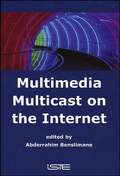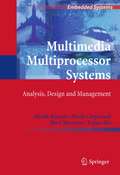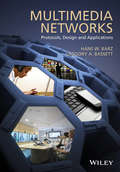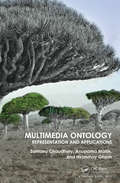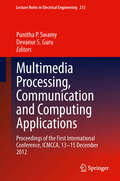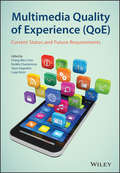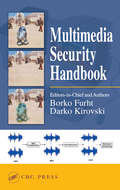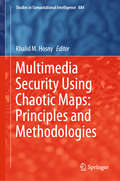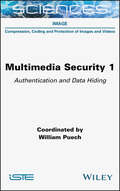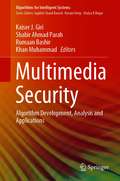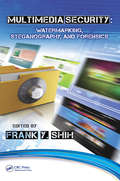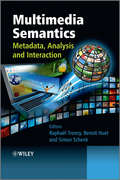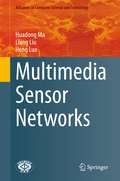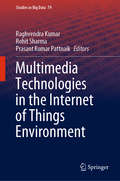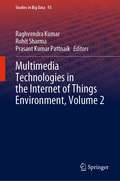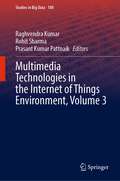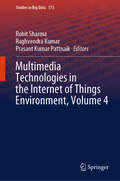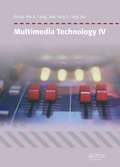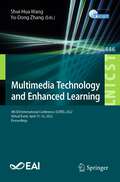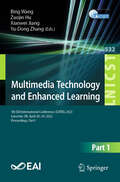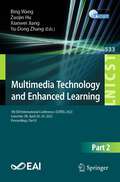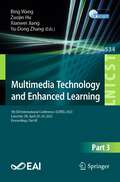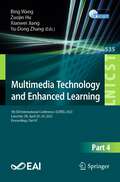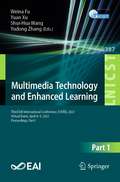- Table View
- List View
Multimedia Multicast on the Internet (Wiley-iste Ser.)
by Abderrahim BenslimaneThis book examines multicast technology and will be a key text for undergraduate engineering students and master students in networks and telecoms. However, it will be equally useful for a wide range of professionals in this research field. Multicast routing was introduced with the advent of multiparty applications (for example, videoconferencing on the Internet) and collaborative work (for example, distributed simulations). It is related to the concept of group communication, a technique introduced to reduce communication costs. The various problems of multicast routing on the Internet are examined in detail. They include: group membership management, quality of service, reliability, safety, scalability and transport. Throughout the text, several protocols are introduced in order to analyze, compare and cover the various aspects of multicast routing.
Multimedia Multiprocessor Systems
by Henk Corporaal Akash Kumar Bart Mesman Yajun HaModern multimedia systems are becoming increasingly multiprocessor and heterogeneous to match the high performance and low power demands placed on them by the large number of applications. The concurrent execution of these applications causes interference and unpredictability in the performance of these systems. In Multimedia Multiprocessor Systems, an analysis mechanism is presented to accurately predict the performance of multiple applications executing concurrently. With high consumer demand the time-to-market has become significantly lower. To cope with the complexity in designing such systems, an automated design-flow is needed that can generate systems from a high-level architectural description such that they are not error-prone and consume less time. Such a design methodology is presented for multiple use-cases -- combinations of active applications. A resource manager is also presented to manage the various resources in the system, and to achieve the goals of performance prediction, admission control and budget enforcement.
Multimedia Networks
by Hans W. Barz Gregory A. BassettThe transportation of multimedia over the network requires timely and errorless transmission much more strictly than other data. This had led to special protocols and to special treatment in multimedia applications (telephony, IP-TV, streaming) to overcome network issues. This book begins with an overview of the vast market combined with the user's expectations. The base mechanisms of the audio/video coding (H.26x etc.) are explained to understand characteristics of the generated network traffic. Further chapters treat common specialized underlying IP network functions which cope with multimedia data in conjunction which special time adaption measures. Based on those standard functions these chapters can treat uniformly SIP, H.248, High-End IP-TV, Webcast, Signage etc. A special section is devoted to home networks which challenge high-end service delivery due to possibly unreliable management. The whole book treats concepts described in accessible IP-based standards and which are implemented broadly. The book is aimed at graduate students/practitioners with good basic knowledge in computer networking. It provides the reader with all concepts of currently used IP technologies of how to deliver multimedia efficiently to the end user.
Multimedia Ontology: Representation and Applications
by Santanu Chaudhury Anupama Mallik Hiranmay GhoshThe result of more than 15 years of collective research, Multimedia Ontology: Representation and Applications provides a theoretical foundation for understanding the nature of media data and the principles involved in its interpretation. The book presents a unified approach to recent advances in multimedia and explains how a multimedia ontology can
Multimedia Processing, Communication and Computing Applications: Proceedings of the First International Conference, ICMCCA, 13-15 December 2012
by Devanur S. Guru Punitha P. SwamyICMCCA 2012 is the first International Conference on Multimedia Processing, Communication and Computing Applications and the theme of the Conference is chosen as 'Multimedia Processing and its Applications'. Multimedia processing has been an active research area contributing in many frontiers of today's science and technology. This book presents peer-reviewed quality papers on multimedia processing, which covers a very broad area of science and technology. The prime objective of the book is to familiarize readers with the latest scientific developments that are taking place in various fields of multimedia processing and is widely used in many disciplines such as Medical Diagnosis, Digital Forensic, Object Recognition, Image and Video Analysis, Robotics, Military, Automotive Industries, Surveillance and Security, Quality Inspection, etc. The book will assist the research community to get the insight of the overlapping works which are being carried out across the globe at many medical hospitals and institutions, defense labs, forensic labs, academic institutions, IT companies and security & surveillance domains. It also discusses latest state-of-the-art research problems and techniques and helps to encourage, motivate and introduce the budding researchers to a larger domain of multimedia.
Multimedia Quality of Experience (QoE): Current Status and Future Requirements
by Luigi Atzori Tasos Dagiuklas Periklis Chatzimisios Chang Wen ChenThis book discusses the current status of QoE research; reporting latest advances from various standardisation bodies (ITU, ETSI, IEEE, IETF) Multimedia Quality of Experience (QoE): Current Status and Future Requirements discusses the current status of QoE (Quality of Experience) research, providing guidelines on QoE assessment and management practice. Moreover, the book covers many different aspects of QoE research, including definition, standardization (ITU, ETSI, IEEE, IETF, etc.), measurement, management, and architectures. In addition, the authors bring together contributions from recognized experts (worldwide) in the area of subjective and objective QoE video assessment. Topics/chapters include: (1) QoE Definition and its relation/mapping to QoS; QoE Standardization activities; QoE Metrics for various media applications; QoE Subjective and Objective Evaluation Methodologies; QoE Control, Monitoring and Management strategies; End-to-End QoE Architectures in heterogeneous environments. Discusses the current status of QoE research; reporting latest advances from various standardisation bodies (e.g. ITU, ETSI, IEEE, IETF) Provides guidelines on QoE assessment and management practice Explores methods, means and architectures of QoE Addresses multiple technologies and requires input from multiple disciplines such as engineering, sociology and psychology Brings together contributions from recognized experts (worldwide) in the area of subjective and objective QoE video assessment Considers future requirements of QoE
Multimedia Security Handbook
by Borko Furht Darko KirovskiIntellectual property owners who exploit new ways of reproducing, distributing, and marketing their creations digitally must also protect them from piracy. Multimedia Security Handbook addresses multiple issues related to the protection of digital media, including audio, image, and video content. This volume examines leading-edge multimedia securit
Multimedia Security Using Chaotic Maps: Principles and Methodologies (Studies in Computational Intelligence #884)
by Khalid M. HosnyThis comprehensive book is primarily intended for researchers, engineers, mathematicians and computer security specialists who are interested in multimedia security, steganography, encryption, and related research fields. It is also a valuable reference resource for postgraduate and senior undergraduate students who are studying multimedia, multimedia security, and information security, as well as for professionals in the IT industry.
Multimedia Security, Volume 1: Authentication and Data Hiding
by William PuechToday, more than 80% of the data transmitted over networks and archived on our computers, tablets, cell phones or clouds is multimedia data - images, videos, audio, 3D data. The applications of this data range from video games to healthcare, and include computer-aided design, video surveillance and biometrics.It is becoming increasingly urgent to secure this data, not only during transmission and archiving, but also during its retrieval and use. Indeed, in today’s "all-digital" world, it is becoming ever-easier to copy data, view it unrightfully, steal it or falsify it.Multimedia Security 1 analyzes the issues of the authentication of multimedia data, code and the embedding of hidden data, both from the point of view of defense and attack. Regarding the embedding of hidden data, it also covers invisibility, color, tracing and 3D data, as well as the detection of hidden messages in an image by steganalysis.
Multimedia Security: Algorithm Development, Analysis and Applications (Algorithms for Intelligent Systems)
by Kaiser J. Giri Shabir Ahmad Parah Rumaan Bashir Khan MuhammadThis book is a collection of outstanding content written by experts working in the field of multimedia security. It provides an insight about various techniques used in multimedia security and identifies its progress in both technological and algorithmic perspectives. In the contemporary world, digitization offers an effective mechanism to process, preserve and transfer all types of information. The incredible progresses in computing and communication technologies augmented by economic feasibility have revolutionized the world. The availability of efficient algorithms together with inexpensive digital recording and storage peripherals have created a multimedia era bringing conveniences to people in sharing the digital data that includes images, audio and video. The ever-increasing pace, at which the multimedia and communication technology is growing, has also made it possible to combine, replicate and distribute the content faster and easier, thereby empowering mankind by having a wealth of information at their disposal. However, security of multimedia is giving tough time to the research community around the globe, due to ever-increasing and efficient attacks carried out on multimedia data by intruders, eves-droppers and hackers. Further, duplication, unauthorized use and mal-distribution of digital content have become a serious challenge as it leads to copyright violation and is considered to be the principal reason that refrains the information providers in freely sharing their proprietary digital content. The book is useful for students, researchers and professionals to advance their study.
Multimedia Security: Watermarking, Steganography, and Forensics
by Frank Y. ShihMultimedia Security: Watermarking, Steganography, and Forensics outlines essential principles, technical information, and expert insights on multimedia security technology used to prove that content is authentic and has not been altered. Illustrating the need for improved content security as the Internet and digital multimedia applications rapidly evolve, this book presents a wealth of everyday protection application examples in fields including multimedia mining and classification, digital watermarking, steganography, and digital forensics. Giving readers an in-depth overview of different aspects of information security mechanisms and methods, this resource also serves as an instructional tool on how to use the fundamental theoretical framework required for the development of extensive advanced techniques. The presentation of several robust algorithms illustrates this framework, helping readers to quickly master and apply fundamental principles. Presented case studies cover: The execution (and feasibility) of techniques used to discover hidden knowledge by applying multimedia duplicate mining methods to large multimedia content Different types of image steganographic schemes based on vector quantization Techniques used to detect changes in human motion behavior and to classify different types of small-group motion behavior Useful for students, researchers, and professionals, this book consists of a variety of technical tutorials that offer an abundance of graphs and examples to powerfully convey the principles of multimedia security and steganography. Imparting the extensive experience of the contributors, this approach simplifies problems, helping readers more easily understand even the most complicated theories. It also enables them to uncover novel concepts involved in the implementation of algorithms, which can lead to the discovery of new problems and new means of solving them.
Multimedia Semantics
by Simon Schenk Raphael Troncy Benoit HuetIn this book, the authors present the latest research results in the multimedia and semantic web communities, bridging the "Semantic Gap"This book explains, collects and reports on the latest research results that aim at narrowing the so-called multimedia "Semantic Gap": the large disparity between descriptions of multimedia content that can be computed automatically, and the richness and subjectivity of semantics in user queries and human interpretations of audiovisual media. Addressing the grand challenge posed by the "Semantic Gap" requires a multi-disciplinary approach (computer science, computer vision and signal processing, cognitive science, web science, etc.) and this is reflected in recent research in this area. In addition, the book targets an interdisciplinary community, and in particular the Multimedia and the Semantic Web communities. Finally, the authors provide both the fundamental knowledge and the latest state-of-the-art results from both communities with the goal of making the knowledge of one community available to the other.Key Features:Presents state-of-the art research results in multimedia semantics: multimedia analysis, metadata standards and multimedia knowledge representation, semantic interaction with multimediaContains real industrial problems exemplified by user case scenariosOffers an insight into various standardisation bodies including W3C, IPTC and ISO MPEGContains contributions from academic and industrial communities from Europe, USA and AsiaIncludes an accompanying website containing user cases, datasets, and software mentioned in the book, as well as links to the K-Space NoE and the SMaRT society web sites (http://www.multimediasemantics.com/)This book will be a valuable reference for academic and industry researchers /practitioners in multimedia, computational intelligence and computer science fields. Graduate students, project leaders, and consultants will also find this book of interest.
Multimedia Sensor Networks (Advances in Computer Science and Technology)
by Liang Liu Hong Luo Huadong MaSensor networks are an essential component of the Internet of Things (IoT), and Multimedia Sensor Networks (MSNs) are the most important emerging area in sensor networks. However, multimedia sensing is characterized by diversified modes, large volumes of data, considerable heterogeneity, and complex computing, as a result of which the theory and methods for traditional sensor networks can’t be applied to MSNs. Based on the authors’ years of systematic research on related theory and methods, this book provides a comprehensive review of MSNs. The coverage ranges from networked sensing and fusion-based transmission, to route discovery and in-network computing. The book presents the most important scientific discoveries and fundamental theories on MSNs, while also exploring practical approaches and typical applications. Given its scope, it is especially suitable for students, researchers and practitioners interested in understanding scientific problems involved in characterizing multimedia sensing features, revealing the transmission mechanisms of MSNs, and constructing efficient in-network multimedia computing paradigms. In this book, readers will learn essential methods for achieving the optimal deployment of, efficient and reliable transmission, and timely information processing in MSNs.
Multimedia Streaming in SDN/NFV and 5G Networks: Machine Learning for Managing Big Data Streaming (IEEE Press)
by Alcardo Barakabitze Andrew HinesMultimedia Streaming in SDN/NFV and 5G Networks A comprehensive overview of Quality of Experience control and management of multimedia services in future networks In Multimedia Streaming in SDN/NFV and 5G Networks, renowned researchers deliver a high-level exploration of Quality of Experience (QoE) control and management solutions for multimedia services in future softwarized and virtualized 5G networks. The book offers coverage of network softwarization and virtualization technologies, including SDN, NFV, MEC, and Fog/Cloud Computing, as critical elements for the management of multimedia services in future networks, like 5G and 6G networks and beyond. Providing a fulsome examination of end-to-end QoE control and management solutions in softwarized and virtualized networks, the book concludes with discussions of probable future challenges and research directions in emerging multimedia services and applications, 5G network management and orchestration, network slicing and collaborative service management of multimedia services in softwarized networks, and QoE-oriented business models. The distinguished authors also explore: Thorough introductions to 5G networks, including definitions and requirements, as well as Quality of Experience management of multimedia streaming services Comprehensive explorations of multimedia streaming services over the internet and network softwarization and virtualization in future networks Practical discussions of QoE management using SDN and NFV in future networks, as well as QoE management of multimedia services in emerging architectures, including MEC, ICN, and Fog/Cloud Computing In-depth examinations of QoE in emerging applications, 5G network slicing architectures and implementations, and 5G network slicing orchestration and resource management Perfect for researchers and engineers in multimedia services and telecoms, Multimedia Streaming in SDN/NFV and 5G Networks will also earn a place in the libraries of graduate and senior undergraduate students with interests in computer science, communication engineering, and telecommunication systems.
Multimedia Technologies in the Internet of Things Environment (Studies in Big Data #79)
by Rohit Sharma Prasant Kumar Pattnaik Raghvendra KumarThis book provides theoretical and practical approach in the area of multimedia and IOT applications and performance analysis. Further, multimedia communication, deep learning models to multimedia data and the new (IOT) approaches are also covered. It addresses the complete functional framework in the area of multimedia data, IOT and smart computing techniques. The book proposes a comprehensive overview of the state-of-the-art research work on multimedia analysis in IOT applications. It bridges the gap between multimedia concepts and solutions by providing the current IOT frameworks, their applications in multimedia analysis, the strengths and limitations of the existing methods, and the future directions in multimedia IOT analytics.
Multimedia Technologies in the Internet of Things Environment, Volume 2 (Studies in Big Data #93)
by Rohit Sharma Prasant Kumar Pattnaik Raghvendra KumarThis book proposes a comprehensive overview of the state-of-the-art research work on multimedia analysis in IoT applications. This is a second volume by editors which provides theoretical and practical approach in the area of multimedia and IOT applications and performance analysis. Further, multimedia communication, deep learning models to multimedia data, and the new (IOT) approaches are also covered. It addresses the complete functional framework in the area of multimedia data, IoT, and smart computing techniques. It bridges the gap between multimedia concepts and solutions by providing the current IOT frameworks, their applications in multimedia analysis, the strengths and limitations of the existing methods, and the future directions in multimedia IOT analytics.
Multimedia Technologies in the Internet of Things Environment, Volume 3 (Studies in Big Data #108)
by Rohit Sharma Prasant Kumar Pattnaik Raghvendra KumarThis book proposes a comprehensive overview of the state-of-the-art research work on multimedia analysis in IoT applications. This is a third volume by editors which provides theoretical and practical approach in the area of multimedia and IOT applications and performance analysis. Further, multimedia communication, deep learning models to multimedia data, and the new (IOT) approaches are also covered. It addresses the complete functional framework in the area of multimedia data, IoT, and smart computing techniques. It bridges the gap between multimedia concepts and solutions by providing the current IOT frameworks, their applications in multimedia analysis, the strengths and limitations of the existing methods, and the future directions in multimedia IOT analytics.
Multimedia Technologies in the Internet of Things Environment, Volume 4 (Studies in Big Data #173)
by Rohit Sharma Prasant Kumar Pattnaik Raghvendra KumarThis book proposes a comprehensive overview of the state-of-the-art research work on multimedia analysis in IoT applications. This is a fourth volume by editors which provides theoretical and practical approaches in the areas of multimedia and IoT applications and performance analysis. Further, multimedia communication, deep learning models to multimedia data, and the new (IoT) approaches are also covered. It addresses the complete functional framework in the areas of multimedia data, IoT, and smart computing techniques. It bridges the gap between multimedia concepts and solutions by providing the current IoT frameworks, their applications in multimedia analysis, the strengths and limitations of the existing methods, and the future directions in multimedia IoT analytics.
Multimedia Technology IV: Proceedings of the 4th International Conference on Multimedia Technology, Sydney, Australia, 28-30 March 2015
by Aly A. Farag Jian Yang Feng JiaoMultimedia Technology IV is a collection of papers from the 4th International Conference on Multimedia Technology (ICMT 2015, Sydney, Australia, 28-29 March 2015). The book discusses a wide range of topics, including: Image and signal processing Video and audio processing Multimedia data communication and transmission, and Multimedia tools. Presenting recent advances and new techniques and applications in image and signal processing, video and audio processing, multimedia data communication and transmission, and multimedia tools, Multimedia Technology IV will be of interest to academics and professionals involved in the field of multimedia technology.
Multimedia Technology and Enhanced Learning: 4th EAI International Conference, ICMTEL 2022, Virtual Event, April 15-16, 2022, Proceedings (Lecture Notes of the Institute for Computer Sciences, Social Informatics and Telecommunications Engineering #446)
by Shui-Hua Wang Yu-Dong ZhangThis proceedings, ICMTEL 2022, constitutes the refereed proceedings of the 4th International Conference on Multimedia Technology and Enhanced Learning, ICMTEL 2022, held in April 2022. Due to the COVID-19 pandemic the conference was held virtually.The 59 revised full papers have been selected from 188 submissions. They were organized in topical sections as follows: internet of things and communication; education and enterprise; machine learning; big data and signal processing; workshop of data fusion for positioning and navigation; and workshop of intelligent systems and control.
Multimedia Technology and Enhanced Learning: 5th EAI International Conference, ICMTEL 2023, Leicester, UK, April 28-29, 2023, Proceedings, Part I (Lecture Notes of the Institute for Computer Sciences, Social Informatics and Telecommunications Engineering #532)
by Yu-Dong Zhang Bing Wang Zuojin Hu Xianwei JiangThe four-volume set LNICST 532, 533, 534 and 535 constitutes the refereed proceedings of the 5th EAI International Conference on Multimedia Technology and Enhanced Learning, ICMTEL 2023, held in Leicester, UK, during April 28-29, 2023.The 121 papers presented in the proceedings set were carefully reviewed and selected from 285 submissions. They were organized in topical sections as follows: AI-based education and learning systems; medical and healthcare; computer vision and image processing; data mining and machine learning; workshop 1: AI-based data processing, intelligent control and their applications; workshop 2: intelligent application in education; and workshop 3: the control and data fusion for intelligent systems.
Multimedia Technology and Enhanced Learning: 5th EAI International Conference, ICMTEL 2023, Leicester, UK, April 28-29, 2023, Proceedings, Part II (Lecture Notes of the Institute for Computer Sciences, Social Informatics and Telecommunications Engineering #533)
by Yu-Dong Zhang Bing Wang Zuojin Hu Xianwei JiangThe four-volume set LNICST 532, 533, 534 and 535 constitutes the refereed proceedings of the 5th EAI International Conference on Multimedia Technology and Enhanced Learning, ICMTEL 2023, held in Leicester, UK, during April 28-29, 2023.The 121 papers presented in the proceedings set were carefully reviewed and selected from 285 submissions. They were organized in topical sections as follows: AI-based education and learning systems; medical and healthcare; computer vision and image processing; data mining and machine learning; workshop 1: AI-based data processing, intelligent control and their applications; workshop 2: intelligent application in education; and workshop 3: the control and data fusion for intelligent systems.
Multimedia Technology and Enhanced Learning: 5th EAI International Conference, ICMTEL 2023, Leicester, UK, April 28-29, 2023, Proceedings, Part III (Lecture Notes of the Institute for Computer Sciences, Social Informatics and Telecommunications Engineering #534)
by Yu-Dong Zhang Bing Wang Zuojin Hu Xianwei JiangThe four-volume set LNICST 532, 533, 534 and 535 constitutes the refereed proceedings of the 5th EAI International Conference on Multimedia Technology and Enhanced Learning, ICMTEL 2023, held in Leicester, UK, during April 28-29, 2023.The 121 papers presented in the proceedings set were carefully reviewed and selected from 285 submissions. They were organized in topical sections as follows: AI-based education and learning systems; medical and healthcare; computer vision and image processing; data mining and machine learning; workshop 1: AI-based data processing, intelligent control and their applications; workshop 2: intelligent application in education; and workshop 3: the control and data fusion for intelligent systems.
Multimedia Technology and Enhanced Learning: 5th EAI International Conference, ICMTEL 2023, Leicester, UK, April 28-29, 2023, Proceedings, Part IV (Lecture Notes of the Institute for Computer Sciences, Social Informatics and Telecommunications Engineering #535)
by Yu-Dong Zhang Bing Wang Zuojin Hu Xianwei JiangThe four-volume set LNICST 532, 533, 534 and 535 constitutes the refereed proceedings of the 5th EAI International Conference on Multimedia Technology and Enhanced Learning, ICMTEL 2023, held in Leicester, UK, during April 28-29, 2023.The 121 papers presented in the proceedings set were carefully reviewed and selected from 285 submissions. They were organized in topical sections as follows: AI-based education and learning systems; medical and healthcare; computer vision and image processing; data mining and machine learning; workshop 1: AI-based data processing, intelligent control and their applications; workshop 2: intelligent application in education; and workshop 3: the control and data fusion for intelligent systems.
Multimedia Technology and Enhanced Learning: Third EAI International Conference, ICMTEL 2021, Virtual Event, April 8–9, 2021, Proceedings, Part I (Lecture Notes of the Institute for Computer Sciences, Social Informatics and Telecommunications Engineering #387)
by Yuan Xu Shui-Hua Wang Weina Fu Yudong ZhangThis two-volume book constitutes the refereed proceedings of the 3rd International Conference on Multimedia Technology and Enhanced Learning, ICMTEL 2021, held in April 2021. Due to the COVID-19 pandemic the conference was held virtually. The 97 revised full papers have been selected from 208 submissions. They describe new learning technologies which range from smart school, smart class and smart learning at home and which have been developed from new technologies such as machine learning, multimedia and Internet of Things.
